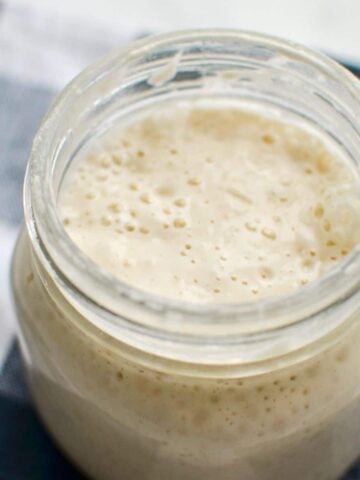If you're looking for a way to preserve your starter for long term storage, keep reading! Did you know that drying sourdough starter can help it last indefinitely? It's also the perfect way to gift or transport your sourdough starter. Not only that, it can be done without special equipment or tools!

One of the best things about keeping an active sourdough starter is (of course) the delicious loaves of sourdough bread! After establishing a routine, maintaining an active starter can be very simple and take up just a few minutes of each day.
But if you're new to sourdough baking, you probably have a level of insecurity about your starter. You may be worried that it will fail. Or maybe you're worried you won't feed it enough, or even forget about it for a while. These things are all real risks, and probably something that every sourdough baker faces at some point.
Maintaining a Backup
Having a backup starter, whether in the fridge, freezer or pantry, is a great insurance policy for your sourdough starter. Having another source ready to go at any given time will help relieve your fears and help you have more confidence in the kitchen as you continue to bake and use your starter.
That's where drying sourdough starter comes in. If you want a backup starter that lasts basically indefinitely, drying your starter is the way to go. It's also an excellent way to ship your starter to friends across the country, or to preserve for a period of recovery like postpartum or illness.
When you dry your sourdough starter and place it in the freezer, it will last indefinitely, meaning you will always have a backup if your main starter goes belly up. Best of all? It's actually so simple to do and it requires no special equipment or tools (although a dehydrator will make it a bit easier).
Let's get started, and I'll show you how to dry out your sourdough starter for long term storage!
Ingredients and Tools Needed

- Sourdough Starter: Your starter should have been recently fed (around 3-4 hours ago), and should be an actively maintained starter. This means it can't have recently come out of the fridge, and should be maintained on the counter for at least the previous 3-4 feedings.
- Parchment Paper: This is the only thing I would recommend, since wax paper has a coating and you will have trouble getting your dried sourdough starter off of plates. Parchment paper works the best for this.
- A pan scraper: If you already use cast iron cookware, you probably have a pan scraper on hand. If you don't, you could totally use the side of a very clean credit or debit card.
Optionally:
- Dehydrator: While you can absolutely dry your sourdough starter at room temperature, using a dehydrator will help you have a better amount of control and your starter may dry a bit quicker. So if you live in a very humid area, or your home is very cold, I would recommend using a dehydrator instead.
Preparing Your Sourdough Starter for Drying

In order to prepare for drying your sourdough starter, you will need to have an active starter. You want that starter to have recently been fed. The perfect time is when it has had several hours to ferment and "eat" through the flour and water.
What you don't want to do, is to use starter that is spent, discarded, or has had a long time since its last feeding. You also don't want to use a starter that has just been fed very recently. Recently fed starters haven't had the chance to work through the flour, and may be too weak to be revived after drying.
Basically, you want to see a good amount of bubbles, like the image above. Your starter need not have doubled or tripled in size yet, although some increase in the size of your starter is a good place to start.
Drying Sourdough Starter for Storage
To start off, cut some parchment paper into a large square about 10-12" wide. If it is very curly, crumple it up in your hand and then flatten it out. This prevents the paper from curling and making a mess of your starter.

Pour approximately ¼ cup of starter onto the parchment paper.

Spreading it Out
Use a pan scraper, or a clean credit card to spread the sourdough in a very fine, even layer. You want it to be as thin as possible so it dries easily and evenly.
Spread it thinly, going over the starter with the pan scraper until the layer is thin enough. Go right to the edges of your parchment paper if necessary.

Drying
Once the starter has been spread very thinly on the parchment paper, leave it in a dry place on your counter. You can also leave it in an open cupboard where it will go undisturbed. Try to pick a location that is dry and has good airflow, rather than a moist area like next to your stove.
Leave your starter to dry for approximately 48-72 hours, or until completed dried.
Some signs that your sourdough is dry enough for storage include:
- Very brittle
- A light color, that is uniform with no dark spots
- No parts of the dried sheet are supple or "bendy"
If your sourdough starter is not completely dry, and has not quite become brittle, allow it to dry for another day or so and then check it again.

Storing Your Dried Starter
Once your starter is completely dry, break it into tiny pieces. Alternatively, you can crush it with a mortar and pestle, OR an extremely clean coffee grinder.
Store the flakes or powder in a plastic zipper bag, and remove any excess air. Store in an airtight container or bag until needed. For an extended storage time, you can freeze your dried sourdough starter.
Reviving Dried Sourdough Starter
I don't currently have a method posted on my blog, but Deanna from Homestead and Chill has a fantastic method for rehydrating and reviving your dried sourdough starter. Once you're ready to rehydrate and revive your stored starter, use her schedule to re-establish an active and thriving starter.
How to Dehydrate Sourdough Starter
If you would like to use a dehydrator to dry your sourdough starter, you can absolutely do that! There are just a few simple steps you need to take:
- Cut a large piece of parchment paper to into a 10-12" square. If your dehydrator is smaller than that, cut the paper to a size that will fit the trays of your dehydrator.
- Pour a small amount of active sourdough starter that has been recently (but not newly) fed. Once your sourdough starter is showing bubbles and signs of activity, you can go ahead and use it for drying.
- Use a pan scraper or a clean credit card to spread the sourdough in a very thin layer. Aim to have as thin of a layer as possible, continuing to spread until the parchment is coated in a skim of the sourdough starter.
- Place your sheet of parchment on one of the trays of your dehydrator, and insert it into the machine.
- Set your dehydrator to the lowest setting possible (normally 80-85°F) and allow to dehydrate for 6-18 hours. Or until the starter is crisp, brittle, light in color, and completely dried out.
- Remove your dried starter from the dehydrator and allow to stand at room temperature until it is cooled completely and very dry.
- Crumble the dried sourdough starter into small flakes, or pulverize in a new (or extremely clean) coffee grinder or high powered blender.
- Place your sourdough flakes or powder into a small zippered bag, and seal completely.
- Store at room temperature for up to 1 year, or in the freezer indefinitely.
Frequently Asked Questions
If you're air drying sourdough starter on the counter, it will typically take 24 hours or up to 4 days. This varies based on the humidity and temperature of your home, with dryer, warmer homes allowing starter to dry more quickly. If you are drying your sourdough starter in a dehydrator, you can expect for it to dry within 6-24 hours, although it may take more or less time based on the style of dehydrator you're using.
For the best results, you want to use a starter that has recently been fed, but has been given a chance to work through some of the feeding. Using a sourdough starter that was fed approximately 3-4 hours ago is a good guideline when seeking to dry starter for preservation and storage.
The best way to preserve dried sourdough starter is to add it to a plastic zipper bag, remove excess air, label, and store in the freezer until needed. If you don't want to keep it in the freezer, you can store it in a cool, dry place for up to 1 year in an airtight plastic zipper bag.
Yes, you can dry sourdough starter in a dehydrator. Just make sure to use the lowest setting (typically 80-85F) to avoid destroying the living organisms. If you dehydrate your starter at a high temperature, you will effectively cook it, destroying the activity that provides the rise and tang of sourdough bread.
When stored at room temperature in an airtight container in a cool, dry place, your sourdough starter should last for 1 year. It certainly may store for longer, but if you want extended storage, move the dried starter to the freezer where it will store indefinitely.
Yes, you can freeze dried sourdough starter. Simply add your sourdough flakes or powder to an airtight plastic zipper bag, OR an airtight container and label. Place in the freezer, and store until you need to use it. It will store indefinitely.
Sourdough starter can be frozen OR dried, according to your preference. It can also be dried, and THEN frozen, if you're looking for an extended storage time. If you will need your sourdough starter again shortly, freezing and thawing may be the best method. If you are looking for extended storage, or for a backup for your active sourdough starter, drying your sourdough starter may be the best option.
Favorite Sourdough Recipes:



- Sourdough Drop Biscuits
- Sourdough Cornbread
- Sourdough Beer Bread
- Sourdough Pie Crust
- Sourdough Texas Sheet Cake

Drying Sourdough Starter
Did you know that you can dry your sourdough starter to save it for a backup or to gift it to another sourdough enthusiast? It's so easy to dry your sourdough starter, and you don't even need a dehydrator!
Materials
- ¼ cup active sourdough starter, recently fed
Tools
- Parchment paper
- Pan scraper (or clean credit card)
Instructions
- In order to prepare for drying your sourdough starter, you will need to have an active starter that has recently been fed, but has had several hours to ferment. You do not want to use starter that is spent, discarded, or has had a long time since its last feeding. You also don't want to use a starter that has just been fed very recently.
- To start off, cut some parchment paper into a large square about 10-12" wide. If it is very curly, crumple it up in your hand and then flatten it out. This prevents the paper from curling and making a mess of your starter.
- Pour approximately ¼ cup of starter onto the parchment paper.
- Use a pan scraper, or a clean credit card to spread the sourdough in a very fine, even layer. You want it to be as thin as possible so it dries easily and evenly. Spread it thinly, going over the starter with the pan scraper until the layer is thin enough. Go right to the edges of your parchment paper if necessary.
- Once the starter has been spread very thinly on the parchment paper, leave it in a dry place on your counter or in an open cupboard where it will go undisturbed. Try to pick a location that is generally dry and has good airflow, rather than a moist area like next to your stove.
- Leave your starter to dry for approximately 48-72 hours, or until completed dried. You will be able to tell, since it will be very brittle and the color will have lightened considerably. If any part of the starter seems supple or "bendy", allow to dry for another day or so.
- Once your starter is completely dry, break it into tiny pieces (or crush with a mortar and pestle) and store in an airtight container or bag until needed. For an ultra long storage time, you can freeze your dried sourdough starter.
Notes
Once you're ready to rehydrate your sourdough starter, follow this method from Homestead and Chill to establish a regular feeding schedule and revive your starter.
More Helpful Sourdough Posts
Please note that some of my blog posts here at Little Home in the Making may contain affiliate links. If you make a purchase through these links, I will get a small commission at no additional cost to you. See our disclaimer for more information.




























Leave a Reply